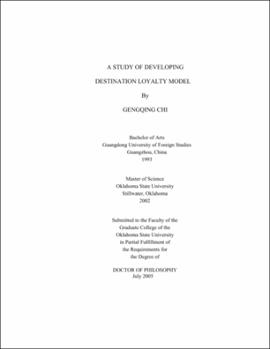| dc.contributor.advisor | Qu, Hailin | |
| dc.contributor.author | Chi, Gengqing | |
| dc.date.accessioned | 2013-11-26T08:33:19Z | |
| dc.date.available | 2013-11-26T08:33:19Z | |
| dc.date.issued | 2005-07 | |
| dc.identifier.uri | https://hdl.handle.net/11244/7209 | |
| dc.description.abstract | Scope and Method of Study: The objective of this study was to 1) develop and test a theoretical model of destination loyalty by analyzing the interrelationships among destination image, tourist satisfaction and destination loyalty; 2) investigate if the destination loyalty model varied among different tourist groups based on previous traveling experiences, age, gender, education, and income level; and 3) measure the service quality of a historic destination. A cross-sectional sample survey was conducted. The target population was all the visitors to a historic destination located in the Mid-west US during a two-month survey period. A two-stage sampling approach including stratified proportionate sampling, and systematic random sampling (SRS) was applied. Structural Equation Modeling (SEM), multiple sample analysis and importance-performance analysis (IPA) were employed for the data analysis. | |
| dc.description.abstract | Findings and Conclusions: The SEM findings supported that destination image was an antecedent of satisfaction. Satisfaction in turn had a positive influence on destination loyalty. Two types of implications were drawn. From a destination management perspective, the importance of improving the image and tourist satisfaction was confirmed. From the research point of view, the systematic examination of causal relationships among the constructs facilitated a clearer understanding of the concept of destination loyalty. It was hoped that the results derived from the model would serve as the basis for the development of destination marketing strategies. The multiple sample analysis revealed that previous experience was the only variable that affected the destination loyalty model. The findings could facilitate destination managers to carry out market segmentation, which is an essential marketing tool in today's increasingly competitive business world and has become part of the everyday thinking of tourism managers in their efforts to improve planning and productivity. The assessment of the quality of the services provided by Eureka Springs would help the city 1) identify and preserve those assets that establish their unique identity and distinguish them from the surrounding areas; 2) pinpoint those areas that require further improvement and promotional efforts; and 3) design a more comprehensive marketing plan, and further expand the market. | |
| dc.format | application/pdf | |
| dc.language | en_US | |
| dc.rights | Copyright is held by the author who has granted the Oklahoma State University Library the non-exclusive right to share this material in its institutional repository. Contact Digital Library Services at lib-dls@okstate.edu or 405-744-9161 for the permission policy on the use, reproduction or distribution of this material. | |
| dc.title | Study of developing destination loyalty model | |
| dc.contributor.committeeMember | Leong, Jerrold K. | |
| dc.contributor.committeeMember | Hu, Bo | |
| dc.contributor.committeeMember | Brown, Tom J. | |
| osu.filename | Chi_okstate_0664D_1513.pdf | |
| osu.accesstype | Open Access | |
| dc.type.genre | Dissertation | |
| dc.type.material | Text | |
| thesis.degree.discipline | Human Environmental Sciences | |
| thesis.degree.grantor | Oklahoma State University | |
